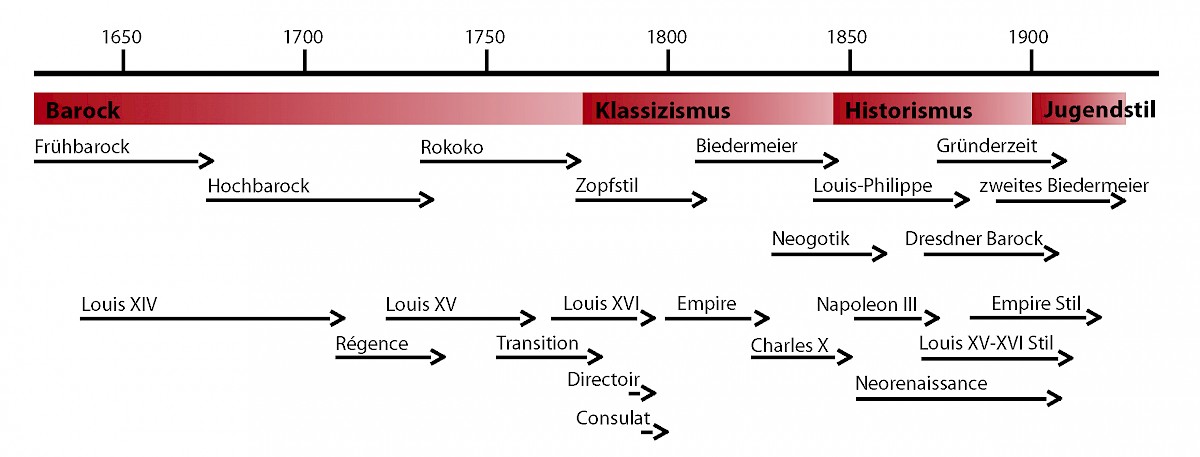The style epochs in furniture making

~1600-1770 Baroque
The stylistic phase of the Baroque is divided in the German countries into Early Baroque (~1600-1670), High Baroque (~1670-1720) and Rococo (~1740-1770). In France we speak of the styles Louis XIV (~1640-1715), Régence (1715-1730) and Louis XV (~1730-1775). Throughout Europe, peoples developed their own furniture styles. Common to all of them are the opulent and heavy forms and ornate fittings.
We call the transitional phase to Classicism (~1760-1780).
~1770-1850 Classicism
The classicist epoch is divided into the early phase, which in Germany we call Zopfstil (~1770-1810) and the late phase, which has become famous under the term Biedermeier(~1810-1840). However, the term Zopfstil never really caught on. Rather, as in the rest of Europe, we speak of the Louis XVI style phase (1775-1792). This was followed in France by the brief Directoire (1795-1799) and Consulate (1799-1804) periods.
The world-famous epoch of the Empire (1804-1814) is followed by the lesser-known phase of the Restoration or Charles X (1814-1830). The transitional phase to Historicism is known as Louis Philippe (1830-1848).
In early classicism, clear structures dominate. Baroque curves are replaced by rectangular fields and straight lines. In the course of the epoch, lines and fields also give way. Cubism establishes itself.
~1850-1910 Historicism
The period of Historicism sees the revival of earlier styles throughout Europe. The epoch of Louis Philippe is considered the last phase of Classicism, but also the early phase of Historicism. It merges seamlessly into the so-called Second Rococo (from ~1850). In general, it is difficult to clearly date and delimit the many individual phases of Historicism. Styles develop simultaneously, in parallel and intermingle.
The first Gothic elements came into fashion as early as the Classicist period. The neo-Gothic style, however, did not emerge as a distinct style until around 1860.
In France, the Napoleon III style (~1860-1880), the Louis XV-XVI style (~1870-1890) and the Neo-Renaissance style (~1860-1900) are of great importance.
In Germany, the most important phase of Historicism is the Gründerzeit (~1870-1910).
~1890-1925 Art Nouveau
Art Nouveau (1890-1920) is a fashion that spread rapidly and evenly throughout Europe as a counter-movement to the stylistic fusions of Historicism. There was a return to a fresh and, above all, a completely new style of its own.
In Germany, the term goes back to the magazine "Jugend", which popularised the new style. In French we speak of Art Nouveau, in English of Modern Style and in Austria the epoch is known as Secession Style. What they all have in common are the floral patterns and shapes and a completely new combination of the materials used.